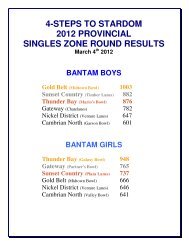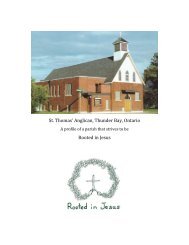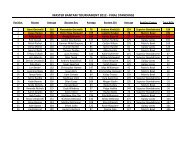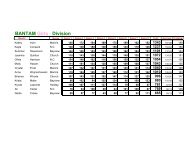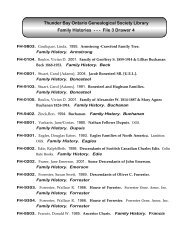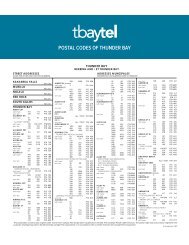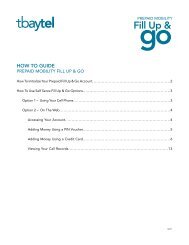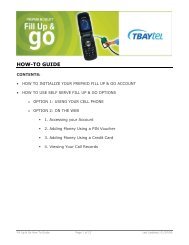Review of Chapters 5 and 6 of the Chemistry Unit
Review of Chapters 5 and 6 of the Chemistry Unit
Review of Chapters 5 and 6 of the Chemistry Unit
- No tags were found...
Create successful ePaper yourself
Turn your PDF publications into a flip-book with our unique Google optimized e-Paper software.
SNC 2D0-01<strong>Chemistry</strong> <strong>Review</strong><strong>Chapters</strong> 5 <strong>and</strong> 6Multiple ChoiceIdentify <strong>the</strong> letter <strong>of</strong> <strong>the</strong> choice that best completes <strong>the</strong> statement or answers <strong>the</strong> question.____ 1. A chemical change is distinguished from a physical change because, in a chemical change, <strong>the</strong> originalsubstance changes itsa. composition. d. mass.b. size. e. state.c. shape.____ 2. A gas is proved to be carbon dioxide if:a. a glowing splint bursts into flames in <strong>the</strong> gas.b. a wet piece <strong>of</strong> red litmus goes blue in <strong>the</strong> gas.c. limewater goes milky when shaken with <strong>the</strong> gas.d. a burning splint causes a small explosion in <strong>the</strong> gas.e. an unlit splint ignites in <strong>the</strong> gas.____ 3. A bright yellow solid substance is known to be an element. It is brittle <strong>and</strong> will shatter if hit with a hammer. Itis a poor conductor <strong>of</strong> both heat <strong>and</strong> electricity. This element is best called a(n)a. alkali metal. d. noble gas.b. metal. e. periodic element.c. nonmetal.____ 4. In <strong>the</strong> Periodic Table, elements with similar properties are grouped ina. diagonal rows. d. vertical columns.b. horizontal rows. e. rectangular blocks.c. periods.____ 5. XF 2 is <strong>the</strong> formula <strong>of</strong> a metallic fluoride. The formula <strong>of</strong> <strong>the</strong> corresponding metallic oxide <strong>of</strong> X isa. XO. d. X 2 O.b. XO 2. e. X 2 O 3.c. XO 4.____ 6. Atoms <strong>of</strong> element A have 2 electrons in <strong>the</strong>ir last occupied orbit. Atoms <strong>of</strong> element B have 7 electrons in <strong>the</strong>irlast occupied orbit. The formula <strong>of</strong> <strong>the</strong> compound formed between A <strong>and</strong> B isa. A 2 B. d. A 7 B 2.b. AB 2. e. AB 5.c. AB 3.____ 7. Select <strong>the</strong> correct corresponding name.a. Sn 2 SO 4 - tin(II) sulfate d. Cu 2 PO 4 - copper(I) phosphateb. PbCO 3 - lead(IV) carbonate e. None <strong>of</strong> <strong>the</strong>se is named correctlyc. Fe(ClO 3 ) 3 - iron(III) chlorate____ 8. When atoms form chemical bonds <strong>the</strong>y cana. gain electrons only. d. lose or gain electrons only.b. lose electrons only. e. share electrons only.c. lose, gain, or share electrons.1
14. Give <strong>the</strong> compound name or formula as required.CaCl 2 Sr 3 P 2BaI 2hydrogen chloridealuminum nitridezinc sulfideNa 3 Npotassium oxidesodium fluoride15. Give <strong>the</strong> compound name or formula as required.Na 2 CO 3 Sn(NO 3 ) 2potassium bromideCu(OH) 2 Al(HCO 3 ) 3zinc chloratepotassium sulfate16. Give <strong>the</strong> compound name or formula as required.SO 2 CF 4NBr 3 CS 2carbon dioxidesilicon tetrabromide17. Give three uses for fossil fuels <strong>and</strong> <strong>the</strong>ir products.calcium phosphatelead(IV) carbonatenitrogen phosphidechlorine oxide18. A chemical reaction is represented by <strong>the</strong> following word equation:magnesium + sulfuric acid → hydrogen + magnesium sulfatea. What are <strong>the</strong> products <strong>of</strong> this reaction?b. What are <strong>the</strong> reactants in this reaction?19. Write word equations for <strong>the</strong> following chemical reactions.a. Tarnish (Ag 2 S) forms when a silver spoon is placed in sulfur.b. KOH <strong>and</strong> H 2 result when H 2 O <strong>and</strong> potassium are mixed.20. One component <strong>of</strong> <strong>the</strong> haze found over industrial areas is ammonium sulfate. It occurs when ammonia <strong>and</strong>sulfuric acid are present in <strong>the</strong> air. Write out <strong>the</strong> word equation for this reaction.21. Complete <strong>the</strong> following word equations.a. copper + silver nitrate → _________ + copper(II) nitrateb. iron + __________ → iron(III) oxidec. lead nitrate + _________ → lead iodide + potassium nitrate22. Balance <strong>the</strong> following equation: PbS + O 2 → PbO + SO 223. Balance <strong>the</strong> following equation: Al 4 C 3 + H 2 O → Al(OH) 3 + CH 424. When sugar, C 6 H 12 O 6 , is strongly heated, water is driven <strong>of</strong>f <strong>and</strong> <strong>the</strong> element carbon is left (something similaroccurs when toast burns).a. Write out a balanced chemical reaction for strongly heating sugar.b. Classify <strong>the</strong> reaction type.3
25. Classify each <strong>of</strong> <strong>the</strong> following as ei<strong>the</strong>r a syn<strong>the</strong>sis or a decomposition reaction.a. Ca + Cl 2 → CaCl 2b. CaCO 3 → CaO + CO 2c. MgO + H 2 O → Mg(OH) 2d. 2 NaHCO 3 → Na 2 CO 3 + H 2 O + CO 226. Write out balanced chemical equations for each <strong>of</strong> <strong>the</strong> following reactions <strong>and</strong> classify <strong>the</strong> reaction type.a. Sodium <strong>and</strong> oxygen react to form sodium oxide.b. Silver oxide when heated produces oxygen <strong>and</strong> silver.c. Magnesium carbonate when heated produces magnesium oxide <strong>and</strong> carbon dioxide.d. Bromine reacts with aluminum to form aluminum bromide.4
<strong>Chemistry</strong> <strong>Chapters</strong> 5 <strong>and</strong> 6Answer SectionMULTIPLE CHOICE1. ANS: A REF: UC LOC: UBC12. ANS: C REF: AS LOC: DS73. ANS: C REF: UC LOC: UBC54. ANS: D REF: UC LOC: UBC15. ANS: A REF: UC LOC: UBC16. ANS: B REF: UC LOC: UBC17. ANS: C REF: UC LOC: UBC18. ANS: C REF: UC LOC: UBC19. ANS: A REF: UC LOC: UBC310. ANS: E REF: UC LOC: UBC3SHORT ANSWER12. ANS:a.b. lithium is <strong>the</strong> metal <strong>and</strong> oxygen is <strong>the</strong> nonmetal.c.d. lithium - 1+ oxygen - 2-e. Li 2 O lithium oxideREF: UC LOC: DS213. ANS:K 2 S - potassium sulfideAg 2 O - silver oxideAlBr 3 - aluminum bromideZnF 2 - zinc fluoridesodium oxide - Na 2 O calcium nitride - Ca 3 N 2lithium iodide – LiIpotassium phosphide - K 3 Pberyllium chloride - BeCl 2 magnesium hydride - MgH 25
REF: UC LOC: UBC114. ANS:CaCl 2 - calcium chlorideBaI 2 - barium iodidehydrogen chloride - HClaluminum nitride - AlNzinc sulfide - ZnSREF: UC LOC: UBC115. ANS:Na 2 CO 3 - sodium carbonateCu(OH) 2 - copper(II) hydroxideMg 3 P 2 - magnesium phosphideNa 3 N - sodium nitridepotassium oxide - K 2 Osodium fluoride - NaFpotassium bromide - KBrSn(NO 3 ) 2 - tin(II) nitrateAl(HCO 3 ) 3 - aluminum hydrogen carbonatezinc chlorate - Zn(ClO 3 ) 2 calcium phosphate - Ca 3 (PO 4 ) 2potassium sulfate - K 2 SO 4 lead(IV) carbonate - Pb(CO 3 ) 2REF: UC LOC: UBC116. ANS:SO 2 - sulfur dioxideNBr 3 - nitrogen tribromidecarbon dioxide - CO 2silicon tetrabromide - SiBr 4CF 4 - carbon tetrafluorideCS 2 - carbon disulfidenitrogen phosphide - NPchlorine oxide - Cl 2 OREF: UC LOC: UBC117. ANS:Examples include: fuel, lubricants, waxes, asphalt, tar, fertilizers, plastics, rubber etc.REF: UC LOC: RST218. ANS:a. The products are hydrogen <strong>and</strong> magnesium sulfate.b. The reactants are magnesium <strong>and</strong> sulfuric acid.REF: UC LOC: UBC319. ANS:a. silver + sulfur → silver sulfideb. potassium + water → potassium hydroxide + hydrogenREF: UC LOC: DS220. ANS:ammonia + sulfuric acid → ammonium sulfateREF: UC LOC: DS221. ANS:a. silverb. oxygenc. potassium iodide6



